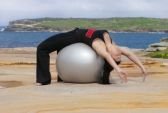
By Cynthia L. Marshall, Ph.D.
Recently, in my college credit class, Yoga II, which studies Ashtanga, the students handed in their papers concerning the changes which they see in their lives which they feel are linked to their intensive study of yoga.
Here are some excerpts from my students' papers:
Yoga changes you from the inside out.
Since practicing yoga, I'm willing to try more foods and eat healthier foods.
Yoga has changed my social nature. . . I have been trying not to just lash out. I have also done a lot of different things for people without receiving credit.
(Megan, 21 years of age)
I feel this semester's poses and workouts have also changed my physical body from the inside.
I think Yoga has also taught me to be positive about my future and teaching as a new career.
I used to worry about everything. I just think now, what can I do? It might not happen, why worry?
(Tina, 35 years of age)
As a yoga teacher within a college setting, I set goals for my students. They write papers, do oral reports, and create models/lessons for yoga class. In terms of grading, I concern myself mainly with their accomplishing the goal, not creating a quality judgment about the goal. Recently, I asked my yoga students to create an art work, a collage, a sculpture, a photo montage, or drawing in which they depicted their yoga journey. I was amazed at the outpouring of creativity.
Not one student said, "I am not an artist." All created sensitive portraits and concepts in a different medium. One student sculpted a lotus blossom out of clay with round seeds which she said were symbols of her different learning experiences in yoga.
At my college, yoga is a three credit course, not a one credit physical education course.
I can't express how fulfilling it is to see the students growing in terms of their practice, how smooth and graceful they have become, how their writing has improved, and now their art work has been an integral part of class.
The teaching of yoga and meditation in a college class is something I wish all could experience, both yoga teachers and students.
Cynthia L. Marshall, Ph.D.
Professor of English and Yoga
1-800-335-0222 ext. 134

















